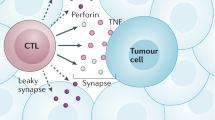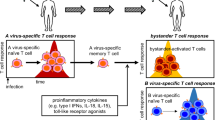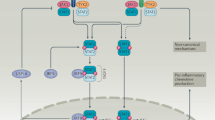Abstract
Interferon was originally described as an antiviral agent produced shortly after onset of infection with most viruses1. However, in addition to inducing an antiviral state, interferon inhibits cell division2, increases the expression of cell-surface antigens3, boosts the cytotoxic activity of natural killer (NK) cells4,5 and modulates several immune functions of lymphocytes and macrophages6–9. Moreover, a special class of interferon (immune interferon or IFN-γ) is produced by T cells following stimulation with antigen or interaction with mitogens10,11. The different methods by which interferon is induced and its multiple effects suggest that it may be part of a first-line defence system controlling the spread of virus infections and the proliferation of modified ‘self’ cells that have been affected by virus infection or neoplastic transformation12. The ability of certain human lymphoma cells to activate the alternative pathway of complement is well established13–15. Here we show that monoclonal antibody-purified interferon can amplify the ability of certain tumour cells to activate complement via the alternative pathway. This demonstration may reflect an additional, as yet unknown, role of interferon in inducing nonspecific anti-tumour immunity.
This is a preview of subscription content, access via your institution
Access options
Subscribe to this journal
Receive 51 print issues and online access
$199.00 per year
only $3.90 per issue
Buy this article
- Purchase on Springer Link
- Instant access to full article PDF
Prices may be subject to local taxes which are calculated during checkout
Similar content being viewed by others
References
Isaacs, A. & Lindenman, J. Proc. R. Soc. B147, 258–267 (1957).
Adams, A., Stronder, H. & Cantell, K. J. gen. Virol. 28, 207–217 (1975).
Lindahl, P., Gresser, I., Leary, P. & Tovrey, M. Proc. natn. Acad. Sci. U.S.A. 73, 1284–1287 (1976).
Gidlung, N., Orn, A., Wigzell, H., Senik, A. & Gresser, I. Nature 273, 759–761 (1978).
Djeu, J. Y., Heinbaugh, J. A., Holden, M. T. & Herberman, R. B. J. Immun. 22, 175–181 (1979).
Gisler, R. H., Lindahl, P. & Gresser, I. J. Immun. 113, 438–444 (1974).
Leanderson, T., Hillorn, V., Holmberg, D., Larsson, E. L. & Lundgren, E. J. Immun. 129, 490–494 (1982).
Donahoe, K. M. & Hung, K. Y. Infect. Immunity 13, 1250–1257 (1976).
Szigeti, R. et al. Nature 288, 594–595 (1980).
Epstein, L. B., Stevens, D. A. & Merigan, T. C. Proc. natn. Acad. Sci. U.S.A. 69, 2632–2636 (1972).
Epstein, L. B., Kerth, W. H. & Herzenberg, L. A. Cell. Immun. 12, 407–421 (1974).
Sonnenfeld, G. in Lymphokine Rep. Vol. 1 (ed. Pick, E. ) 113–131 (1980).
Budzko, D. B., Lachmann, P. J. & McConnell, I. Cell. Immun. 22, 98 (1976).
Theofilopoulos, A. N. & Perrin, L. H. J. exp. Med. 143, 271 (1976).
Schreiber, R. D., Pangburn, M. K., Medicus, R. G. & Müller-Eberhard, H. J. Clin. Immun. Immunopath. 15, 384 (1980).
Epstein, M. A. et al. J. natn. Cancer. Inst. 37, 547–559 (1966).
Menezes, J., Leibold, W., Klein, G. & Clements, G. Biomedicine 22, 267–284 (1975).
Fresen, K. O. & Zur Hausen, H. Int. J. Cancer 17, 161–166 (1976).
Yefenof, E., Kledin, G. & Kuarnung, K. Cell. Immun. 25, 225–233 (1977).
McConnell, I., Klein, G., Lint, T. F. & Lachmann, P. J. Eur. J. Immun. 8, 453–458 (1978).
Okadao, H. & Baba, T. Nature 248, 521–522 (1974).
Trinchieri, G. & Santoli, D. J. exp. Med. 147, 1314–1333 (1978).
Secher, D. S. & Burke, D. C. Nature 446–450 (1980).
Lachmann, P. J. & Hobart, M. J. in Handbook for Experimental Immunology 3rd edn (ed. Weir, D. M. ) Ch. 5A (Blackwell Scientific, Oxford, 1978).
Author information
Authors and Affiliations
Rights and permissions
About this article
Cite this article
Yefenof, E., McConnell, I. Interferon amplifies complement activation by Burkitt's lymphoma cells. Nature 313, 684–685 (1985). https://doi.org/10.1038/313684a0
Received:
Accepted:
Issue Date:
DOI: https://doi.org/10.1038/313684a0
Comments
By submitting a comment you agree to abide by our Terms and Community Guidelines. If you find something abusive or that does not comply with our terms or guidelines please flag it as inappropriate.



